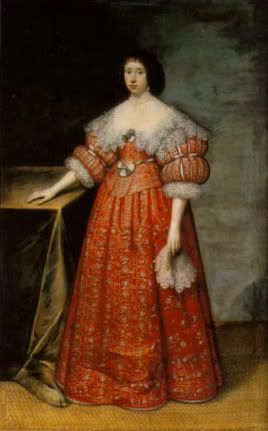K.McClainENG227
kiara_mcclain
|
Women Changing: The Evolution of Women in Puritanism |

Mary Barret Dyer
Dyer is Dressed in the Customary Puritan Clothing of the late 1700s
@
According to the Women History online, Mary Barret Dyer was married to William Dyer, soon to be a freeman of the Massachusetts Bay Colony. The two emigrated from England in 1635 to settle in the United States. They were later banned from the Church in 1638, due to their support of Anne Hutchinson who was excommunicated from the Church (http://womenhistory.blogspot.com/2007_10_01_archive.html). http://i157.photobucket.com/albums/t45/maggie6138/puritanwoman.jpg |
Women Writers
Women, like Bradstreet first began to publish their writings through poetry. In fact, Anne Bradstreet herself was the first woman to publish poetry within the colonies of New England. The reason for her acceptance, or at least toleration for her work came from her use of religious tone for piety and faith in God. Many women after her, such as Mary Rowlandson would keep religion as a major theme of their writing to keep their audiences. Bradstreet is noted upon for her rhetoric; in "The Prologue" she "claims of male supremacy to all areas of human experience, she seems to dismiss hopes for female excellence in government, oratory, and poetry" (Eberwein 14). By claiming "male supremacy to all areas of human experience" Bradstreet is ironically claiming that since men portray themselves as capable to doing everything, they must also have the ability to even do "needlework and childbearing," items subjugated strictly to women (Eberwein 14).
|
This article, Female Piety in Puritan New England: The Emergence of Religious Humanism by Amanda Porterfield discusses Puritan ideals about the "relationship between God and the Church" and how this ties "into social practice" (Porterfield 1). Here it also gives a clear example of how the relationship between "God and the Church" provided an understanding of how Puritans treated marriage and "the context of domestic life" (Porterfield 1). According to Porterfield, women would be subject to a "hierarchial marriage as the basic unit of Puritan social order" (Porterfield 1). |
Along with being coercion to follow the interpretion "between God and the Church" as Porterfield outlines in her article, women had to be submissive to their husbands and his demands. Many women were objectified into following this interpretation; however, some women were fortunate enough to not have to fully succumb to their husbands. This is apparent for those women who were educated, and could were granted permission to write from their husbands. This example is shown again by Bradstreet, Rowlandson, and later women writers such as Sedgwick, Kirkwood, and Osgood. Early women writers such as Bradstreet and Rowlandson are different from later American women writers in that they use religious rhetoric; they use their own religious testimony to persuade their audience towards God, and thus keep their attention and recognition of their writing. This is due to the Politics of Puritanism which "drove political and historical messages in the literature of the early republic," according to Shirley Samuels in Affective Politics (Samuels 1). Other women writers embedded domesticity within their writings in order to obtain more of a female audience.
Article Retrieved at: http://www.jstor.org/sici?sici=0029-5132%28199821%2931%3A2%3C266%3AAP%3E2.0.CO%3B2-6&origin=thenines
"The Pilgrim's Progress" and Traditions in Puritan Meditation by U. Milo Kaufmann discusses how Puritans "interpret biblical events and personages as relevatory of doctrine and example rather than as multi-faceted reality" (Kaufman 86). Kaufman also touches upon how Puritans portray themselves, and a reason to why they rely so heavily on Christin doctrine in determing the social context of their lives, from marriage to gender roles.
Article retrieved at: http://www.jstor.org/stable/1345359?seq=2
In conclusion, I find that in order for women to be successful in literature, they published items of religious relevance. Literature that served as religious testimonies, helped to serve the community they lived in because the fears of living in an unknown land, such as America. I propose that Bradstreet was so successful in gaining her audience because of this fact; she was able to show that women could still have the proper piety and closness to God, even as a writer. Bradstreet and early writers who copied this religious model within their writing laid the groundwork for other women writers. The evolution of the tone and themes of women writers changes from Bradstreet, who utlilizes religion as her theme to authors such as Harriet Beecher Stowe, who are more free in the nineteenth century to less subtly voice their criticisms to social order and hierarchy.

